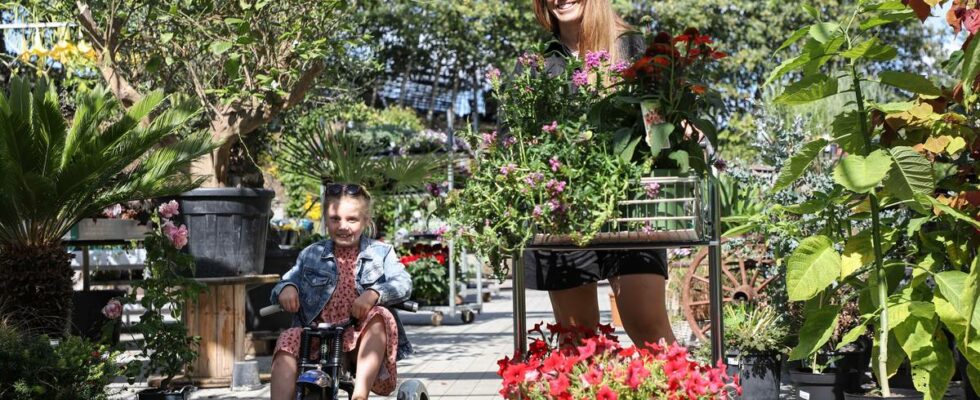– It is often cheaper at the end of the season, says Silje Karlsen. Both perennials, hedge plants and urns have been reduced by between 30 and 50 per cent at Spanne Plantesal in Karmøy, where Karlsen made the shopping trip. In the basket she has Petunia and Sun Hat. Perennials that do not require too much care. And it fits extra well this year. – I came home from four weeks of holiday to a garden that was completely withered, so then I have to renew it quite a bit, she says. Silje Karlsen fills the trunk with fresh flowers and has promised herself that almost summer she will ask her neighbor for water when she herself is on holiday. Photo: Marthe Synnøve Johannessen / news Karlsen must take extra care of the new plants. And it’s a good idea because plants and other garden products are constantly increasing in price, figures from Statistics Norway show. Based on the Consumer Price Index from the base year 2015 to 2023, news has compared garden products, food products, clothing and shoes and holiday trips. The graph shows that flowers and garden products have increased by almost 40 per cent since 2015. In comparison, food has increased by 27.3 per cent, while holidays have become 68.6 per cent more expensive. Weak krone and high fertilizer prices In a shorter perspective, the 12-month growth in June this year was 4.5 per cent for plants and garden products. This means that goods in this group cost 4.5 per cent more than they did in June last year. In April, growth was a whopping 8.9 per cent. – This is above the total price increase we had in June, which was 2.6 per cent. And if we look further back in time for this group, we see that price growth has been quite a lot higher in the last three years, says adviser at Statistics Norway, Trym Kristian Økland. He points to two things that have influenced the price. – The exchange rate and the price of fertiliser. The Norwegian krone has been very weak, especially in the last year. It affects this group quite directly because many of the goods are imported, he says. The price of artificial fertilizer has also increased sharply from the start of 2021. – Even though the price has fallen somewhat, it is still at a fairly high level, says Økland. Rescued people should stop shopping The Norwegian Horticultural Association says they notice concern among their members. – They fear that it will be too expensive to run Norwegian production. We are completely dependent on Norwegian consumers choosing Norwegian plants. We have no other place to sell the plants than to Norwegian consumers, says Sidsel Bøckman, deputy director of the Norwegian Gardeners’ Association. Deputy owner of the Norwegian Gardeners Association Sidsel Bøckman. Photo: Dag Eivind Gangås They are also afraid that consumers will cut out flowers and plants when everything becomes more expensive. Norwegian production is dependent on input factors such as seeds, small plants and technical equipment that are imported from abroad, she explains. But with a weak krone exchange rate, this will be much more expensive than before. – When the costs of producing increase, we see stiffer competition from imports. There is weak customs protection for flowers and plants in Norway, so there is a concern that this could make Norwegian flowers and plants more expensive than imports, she says. Money to save Henry Tendenes is the leader of the national board of Det norske hageselskap. Price increases are something they talk about all the time. – People say that yes, it has become more expensive, but at the same time they understand that production and plants themselves are part of an increase in costs that we just have to reckon with, he says. Leader of the national board of Det norske hageselskap Henry Tendenes. Photo: Privat But gardeners are extra aware of sharing plants with others now. – When you visit, you like to bring a plant that someone has seen in your garden and talked about well before. Then it will be good for you to share with others, and at the same time it is good for the plant. They occasionally need a bit of space around their roots, says Tendenes. Sharing plants is just one of many saving tips in the garden. Below you get five more. Do you have more? Feel free to share them in the comments section. Saving tips for gardeners: Photo: Marthe Synnøve Johannessen / news Share plants with others. It is good for the perennials to be shared and nice for the recipient. Use nature, as long as you know what you are doing. Henry Tendenes’s favorite is Tiriltunge, and you can get it for free in nature in almost all of Norway. More and more libraries have seed libraries. “Borrow” and return your own seeds for the enjoyment of others. Go to a flea market. Join plant swap groups on Facebook. Give the plants good soil and remember to fertilize. Harvest from own and others’ gardens. Buy seeds and grow the summer flowers yourself. Seeds are often sold cheaper in autumn. Large and exotic plants are often extra expensive to purchase and many are perennial. They will be even nicer if they are allowed to overwinter inside. Sources: Henry Tendenes, Haugesund public library, Marianne Uteengen – subject manager at Det norske hageselskap. Hello! Welcome to dialogue at news. Since you are logged in to other news services, you do not have to log in again here, but we need your consent to our terms of use for online dialogue Published 11.08.2024, at 14.04
ttn-69
Weak krone means more expensive plants, but there is money to be saved in the garden – news Rogaland – Local news, TV and radio

